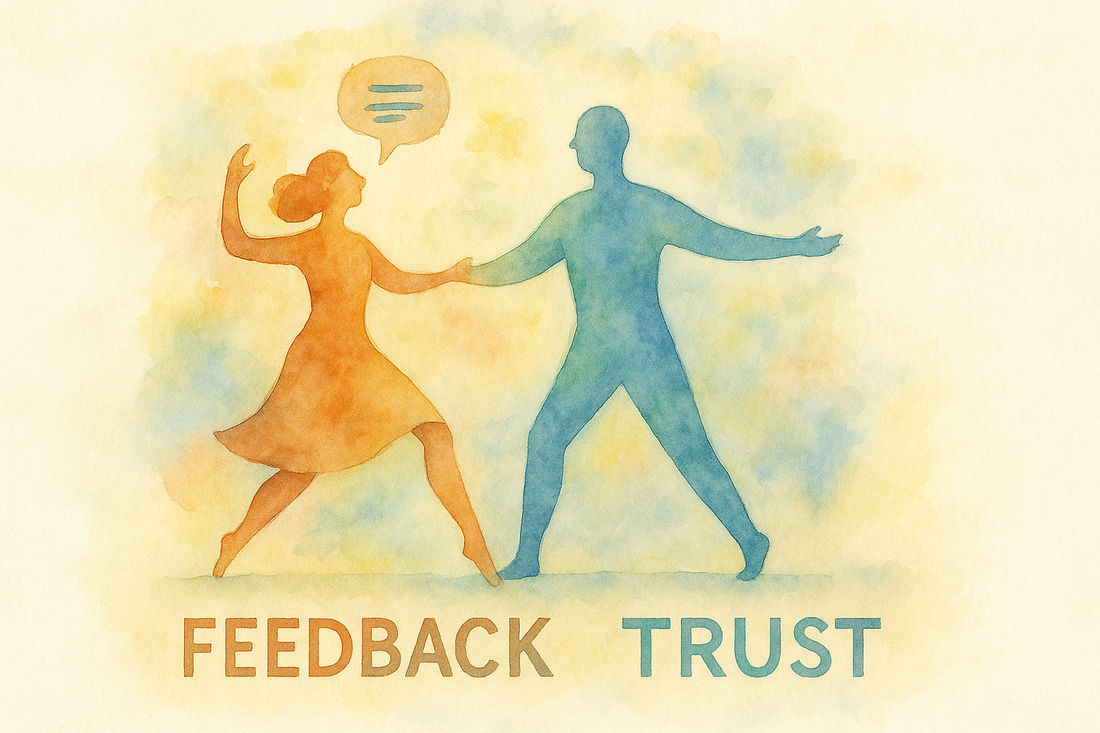
Feedback & Trust: The Essential Dance of Modern Leadership
Share
Feedback & Trust: The Essential Dance of Modern Leadership
Let’s be honest:
Feedback, when done poorly, is like a birthday gift still wrapped in the store bag — and inside? A sock. And trust? Takes months to build and just 30 seconds to blow up.
But — when handled well, feedback and trust become the heartbeat of extraordinary teams.
We’re not talking about “performance reviews,” but real, alive conversations, human connection, and mutual commitment to growth.
The Problem? We confuse feedback with criticism, and trust with “don’t bother me.”
It’s time to fix that. No hollow formulas. Here’s a practical, provocative, and creative guide to lead with courage, real listening, and actual impact.
1. Feedback is a Conversation, Not a Verdict
If your feedback starts with “you need to improve…” — pause. Breathe. Rewind.
New mindset:
Feedback isn’t about correcting. It’s about building bridges of awareness.
Try this: 3D Feedback Technique
-
Describe what you observed (no judgment);
-
Declare the impact (on you or the team);
-
Dare them with a small, specific action.
Example:
“In the meeting, I noticed you interrupted João twice (describe). I think that made him shut down a bit (impact). What do you think about pausing before jumping in next time? (dare)”.
2. Trust Can’t Be Bought — It’s Built
Trust doesn’t magically show up during onboarding.
It grows from small, intentional, consistent moments.
The twist?
How you give feedback is one of the clearest signs someone can trust you.
Practical tool: The Trust Thermometer
-
Cold: Team’s silent, no one shares bold ideas
-
Warm: Feedback happens, but only among the “inner circle”
-
Hot: People ask for feedback and even challenge the leader

Your role as a leader?
Spot where your team’s at and warm up the room — with psychological safety and genuine curiosity.
3. Make Feedback a Ritual (Yes, like a feel-good mini-cult)
Feedback needs rhythm — not just good intentions.
Turn it into a collective habit through simple, steady rituals.
Rituals that work:
-
Weekly check-out: Everyone gives + receives 1 praise + 1 suggestion in 2 minutes;
-
Trust retros: Use Start, Stop, Continue only for behaviors (not tasks);
-
Anonymous (but heartfelt) letters: Once a month, handwrite a note about something you admire in a teammate.
When feedback becomes a habit, it stops being scary and starts being a shared language.
4. Feedback Without Authenticity Is Just Theater
Nothing kills trust faster than a leader with a pasted-on smile and a script that ignores who’s in the room.
Be vulnerable.
Say “I don’t know” when you don’t.
Ask for feedback — and show that you take it seriously.
Share your own learning curve.
Practical dare:
At your next retro, share a mistake you made and what you learned.
It’ll create more space for honesty than any PowerPoint slide about “company values.”
5. Trust Is the Team’s Immune System
Real trust allows for:
-
Healthy disagreements;
-
Fearless innovation;
-
Sustainable, real growth.
But watch out — trust doesn’t run on autopilot.
It needs to be fed, watered, and protected — with real talk, active listening, and emotional availability.
Create horizontal feedback systems (peer-to-peer, not just top-down), make room for tough conversations, and celebratewhen someone speaks their truth.
Leadership Is Relational, Not Just Functional
The leadership of the future?
It doesn’t live in frameworks or KPIs.
It breathes in relationships. In small gestures. In hard conversations.
Feedback and trust are the two pillars that hold up a vibrant team culture.
But they only work when they’re real, consistent, and deeply human.


By: Mayume Wegner
Linkedin
Supplementary Reading
